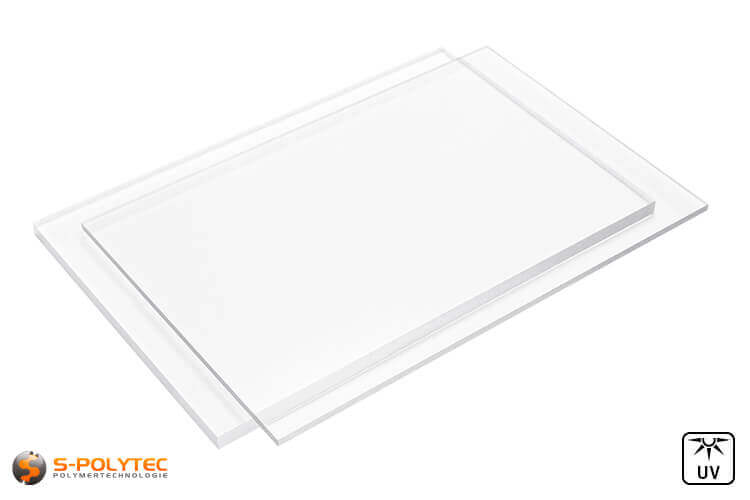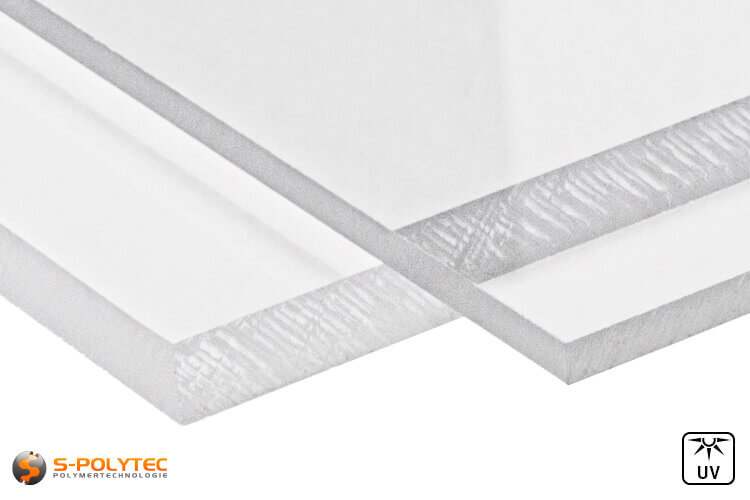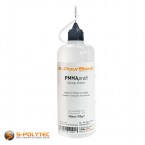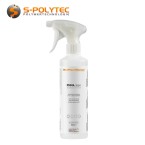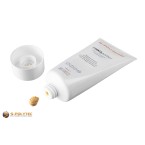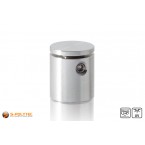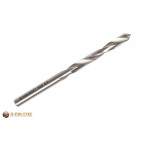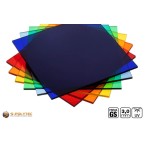
Transparent acrylic glass GS cut to size (colourless)
Our cut-to-size acrylic glass GS in colourless, transparent is highly weather-resistant and impresses with its excellent surface quality, which extruded acrylic glass cannot match. The crystal-clear sheets are extremely resistant to ageing and are suitable for indoor and outdoor applications.
✓ UV- and weather-resistant
✓ Enormous ageing resistance
✓ Cast version
✓ Crystal clear, transparent
✓ Light transmission 92%
The transparent acrylic sheets in cast design are available in thicknesses from 3mm to 10mm cut to size.
The item is in stock
Dispatch within 2-3 working days
- Panels in Cut
- at pieces 0,00 € (Base Price 0,00 € / m2)
- at pieces 0,00 € (Base Price 0,00 € / m2)
- at pieces 0,00 € (Base Price 0,00 € / m2)
All prices include 19% VAT.
0,00 € / pc.
0,0000kg / pc.
All prices include 19% VAT.
- Description
Buy acrylic glass GS cut to size online
UV- & Weather-resistant ✓ Colourless, transparent ✓ Precise cutting ✓
We offer the transparent sheets of acrylic glass GS cut to size in the thicknesses 3mm, 4mm, 5mm, 8mm and 10mm at favourable prices. The acrylic glass sheets are highly transparent and crystal clear. Acrylic glass GS is characterised by a very high UV and weather resistance. In addition, the sheets are waterproof and extremely resistant to ageing, making them suitable for outdoor use without hesitation. To protect the glossy, mirror-smooth surfaces from scratches and damage before and during processing, the sheets are equipped with a high-quality protective film on both sides, which can be easily removed.
Our modern CNC panel saws for horizontal cutting are used for cutting acrylic glass GS. These allow extremely gentle processing of the sheets, as well as a very low tolerance of +/- 1mm. Acrylic glass cuts are possible from a size of 30mm x 30mm. The maximum format for online orders of our cast sheets in colourless, transparent design is 1500mm x 1000mm. However, larger cuts are possible on request.
Properties of the transparent acrylic glass GS cut to size
Acrylic glass GS is cast. This means that the basic material is melted down and poured into a mould between two sheets, resulting in a sheet with a high-quality and smooth surface. This process is more elaborate than the extrusion of plastic sheets, which in turn is reflected in a somewhat higher price. However, casting has the advantage that the sheets have no internal stresses, making acrylic GS less prone to stress cracking. In addition, the surface quality and the optical quality of the surface are higher than with extruded sheets. However, the thickness tolerances of GS acrylic glass can be somewhat higher. Another advantage is that cast acrylic is easier to polish or process. With laser cutting, for example, the edges appear considerably smoother than with acrylic glass XT.
Due to the different manufacturing process, cast acrylic glass is characterised by even better UV and weather resistance than extruded acrylic glass. It is enormously resistant to ageing, does not yellow and does not become rough or brittle due to weathering. Cast acrylic can also convince in a direct comparison with regard to the outstanding surface quality. At approx. 92%, they have a higher light transmission than conventional glass, are significantly lighter and more impact-resistant than a pane of glass of comparable size.
Due to the saw cut, the cut edges are saw-rough. In most cases, the cut edge only plays a subordinate role, so that further edge processing is not necessary. For acrylic glass in 3mm and 8mm, we also have high-quality aluminum profiles for covering the edges, which are pushed onto the edge. Especially for partition walls, the solid aluminum profiles contribute to an increased rigidity of the acrylic panels.
Application examples for transparent acrylic GS
Acrylic glass is suitable for countless applications in which conventional glass is also used, but it has a few notable advantages over glass. For one thing, the light transmission of acrylic glass is higher than glass at around 92%. In addition, acrylic is easier to work with and does not shatter as much as glass when broken. While glass processing requires special tools and can usually only be carried out by specialist companies, acrylic glass can also be processed in the home workshop with simple tools.
Acrylic glass is much more impact-resistant than a glass plate of the same size and thickness. In addition, acrylic glass weighs significantly less. It is precisely this weight advantage that contributes to this plastic being used for lightweight glazing in caravans, motor homes and boats, where every gram of weight saved counts. In terms of UV and weather resistance, acrylic glass is in no way inferior to real glass. Acrylic glass GS in particular, which has an even higher UV and ageing resistance than acrylic glass XT, is perfect for permanent use as glazing in outdoor areas. For example, for the construction of side walls for patio roofs, pergolas or as windbreaks.
Indoors, transparent acrylic glass is well suited for transparent partitions and protective walls. Especially recently, this plastic has been used as a virus protection screen in checkout and waiting areas. With a very low water absorption of less than 0.3%, acrylic glass can also be used as a waterproof plastic in bathrooms for lightweight shower partitions. Even permanent contact with water is possible, which is why acrylic glass is also well suited for terrariums and aquariums.
Acrylic glass is also very much used for decorative purposes. These include direct prints on the back with a special depth effect, as well as company signs or UV-protective glazing in art galleries and museums. Due to the deep-drawing ability of acrylic glass, individual shapes for the production of art objects, lights or decorative articles are also possible and quite timelessly popular.
- Acrylic glass GS is enormously UV & weather resistant and ideal for crystal-clear side walls for patio roofs
- Acrylic GS can be perfectly used as weight-reducing glazing in caravans, caravans and mobile homes
- Acrylic glass GS is used in art galleries for framing prints, lithographs and photographs as UV protection
- Acrylic glass GS is waterproof and suitable for shower partitions due to the scratch-resistant surface
- Acrylic glass GS can be used for the production of high-quality aquariums and terrariums
- And many more
Processing of cast acrylic sheets
Our acrylic glass GS is cut to size in the desired size so that no further cutting is necessary. Nevertheless, the material can be processed in many ways without the need for special tools or machines. This is one of the reasons why the transparent plastic sheets are so popular with hobbyists, DIY enthusiasts and craftsmen.
Acrylic glass GS cutting and drilling
Acrylic glass can be sawn or milled very easily. However, there are a few points to bear in mind. Although acrylic glass is up to 10 times more impact-resistant than glass, it can break when mechanically processed. Therefore, when sawing and drilling, the sheet should always rest on a firm base and care should be taken that it does not have too much play for vibrations caused by the saw blade. In addition, a suitable saw blade should be used for PMMA, as this has less coarse toothing than conventional wood saw blades. Saw blades for metal are only suitable to a limited extent, because they are much too fine. Regardless of whether a circular saw, a jigsaw or, as in the case of our acrylic glass cuts, a panel saw is used, the speed should be very low so that the saw blade does not become too hot. Since milling, for example, for cut-outs, edge frames or countersinks, is also a cutting method, the speed and feed rate must be reduced and a suitable milling cutter must be used.
Basically, acrylic glass can be drilled with any commercially available HSS drill bit. Most drill bits for metal have a point angle of 118°, as well as a normal spiral twist, which is perfect for drilling aluminium, iron or steel. When drilling hard, brittle plastics, which also include acrylic and plexiglass®, a special plastic drill type HK is more suitable. With such drills, the spiral that discharges the drill chip is elongated. The drill point is also much more pointed with a point angle of 80°. This allows the drill to glide better through the hard surface and does not heat up as much, which results in more precise drilling without chipping when the drill comes out. As with all plastics, a low speed should be selected for acrylic glass. In addition, the sheet should rest firmly on a base to reduce the risk of breakage due to excessive vibrations.
The rough edges that occur when cutting with a saw can be smoothed with very fine-grained sandpaper or a sanding block. Finally, the last fine grooves can be polished out with acrylic and Plexiglas polish and a polishing attachment for cordless screwdrivers. Alternatively, a commercially available gas burner can be used for flame polishing, in which the cut edges are worked on with the hot flame until they are clear and transparent. Caution is advised here, because if the hot flame remains in one place for too long, the surface will burn, resulting in the formation of bubbles with soot inclusions that can only be removed again with great effort.
As an alternative to cutting methods, acrylic glass GS can be excellently cut with a CO2 laser. This allows extremely low manufacturing tolerances and impresses with a crystal-clear cut edge, which makes further edge processing for polishing unnecessary. PMMA can also be engraved very well with a laser. We offer the transparent acrylic sheets in laser cut. With our laser part configurator, individual shapes can be conveniently configured online in addition to rectangular formats.
WARNING: When laser cutting, the protective film should be removed beforehand so that the film does not fuse with the cut edge and is thus difficult to remove.
Acrylic glass GS printing, lacquering and foiling
Printing on acrylic glass using the direct printing process is very popular for company signs and wall decorations and is offered by many online printers. However, the acrylic sheet is not printed on the visible front side, but on the back side. It should be noted, however, that the motif must be mirrored beforehand, otherwise it will be displayed upside down. The direct printing process creates a special depth effect, which contributes to a special eye-catcher in every living room. The higher the panel thickness, the more brilliant the appearance and depth effect of the image.
It is somewhat cheaper to stick a digital print on the back of the acrylic glass plate. However, care must be taken to ensure that the print is bonded to the surface of the sheet without bubbles, as any air pockets, no matter how small, will be clearly visible later on the front of the picture. Instead of gluing, you can also simply place a poster, an art print or a large-format photo between two acrylic glass sheets and glue, screw or rivet them together. Although the effect is not quite as good as the direct printing process, it still provides a very special look and brilliance.
Cast acrylic glass can also be labelled with an adhesive film. With our high-quality spacers made of solid stainless steel, attractive company signs, notice boards or door signs can be erected in no time at all. The cast PMMA is also very suitable as a transparent whiteboard. Cleaning with a soft, lint-free cloth leaves no scratches on the hard surface.
Glue and seal acrylic glass GS
Acrylic is easy to bond and can be bonded with almost any solvent-based adhesive. Both with each other and with other plastics that can be bonded with a solvent adhesive. With our Acrylic and plexiglass®-glue PMMAprofi,we offer a high-quality adhesive that bonds the parts to be joined using the cold welding method. Due to the thin, water-like viscosity, a high capillary effect is achieved. As a result, the special adhesive can penetrate into every finest gap and enable an almost invisible bonded joint. An essential feature of cast acrylic glass is that no stress cracks occur at the cut edges when it comes into contact with solvent-based adhesives, because acrylic glass GS is free of internal stresses due to the manufacturing process.
For bonding with other materials, our MS polymer in transparent is a good choice. For tight sealing, especially when sealing joints between two acrylic sheets, any silicone can be used, but the Silicone sealant Parasilico PL here a significantly higher adhesion, while at the same time very high transparency and was specially developed for sealing and sealing acrylic glass and polycarbonate.
Cleaning acrylic glass GS
Acrylic glass sheets made of cast material have a very smooth surface that is very easy to clean. However, PMMA is sensitive to solvents and alcohols, so care must be taken to ensure that the cleaner is suitable for acrylic glass. Furthermore, only soft, lint-free cloths should be used. Microfibre cloths are generally not suitable for smooth or lacquered surfaces because they cause fine scratches that are more or less visible depending on the intensity of the cleaning. This applies not only to acrylic glass, but to all smooth surfaces. Even real glass is no exception.
WARNING: The acrylic glass sheets are provided with a protective film, which must be removed beforehand depending on the further processing. This includes gluing, sticking, printing, laser cutting, engraving or even deep-drawing, because the film cannot be deep-drawn and serves to protect the surfaces from scratches that could occur during the processing of the sheets.
- Additional Information
Additional Information
Product-ID 50000C Thickness 3mm - 10mm Standart Length 3050 Standard width 2050 Delivery Time Dispatch within 2-3 working days Plastic Acrylglas Material PMMA UV resistance UV resistant Color Colorless Color accuracy No Color designation Transparent - Reviews
- Attachments
